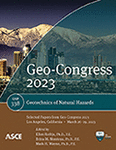Evaluation of Two Numerical Modeling Approaches for Liquefaction Investigation of Fines-Dominated Soils in Wildlife Liquefaction Array (WLA) Case Study
Publication: Geo-Congress 2023
ABSTRACT
Soil liquefaction evaluation is critically important in site seismic analyses. The presence of fines-dominated materials such as clayey and silty soils has been reported in many of the occurred liquefaction cases. Despite this observed fact, there are limited studies analyzing the presence of such materials in liquified sites compared to sandy sites. One of the practical methods to analyze such sites is to use Finn-Byrne formulation for pore water pressure buildup calculation along with other constitutive models such as simple Mohr-Coulomb. Recent advancements in constitutive models with more sophisticated PM4Silt and PM4Sand models allowed a more rigorous liquefaction analysis of such sites. In this study, these two modeling approaches are applied to Wildlife Liquefaction Array (WLA) monitored site. The WLA site profile consists of about 2.5 m of surface silty soil, 4.5 m of silty sand, followed by 5 m of silty clay, and a thick silty layer at the bottom. The liquefaction analyses of the WLA site under the 1987 Superstition Hills earthquake were conducted using these two approaches and compared to observed liquefaction. The results of the study showed that both approaches, despite significant differences in their theory and input parameters, have the capacity of predicting excess pore water pressure (EPWP) generation in the non-plastic silty layers. However, the PM4Silt model was able to produce a better prediction of EPWP variations in the low-plasticity, non-liquefiable deep silty layer during the earthquake.
Get full access to this article
View all available purchase options and get full access to this chapter.
REFERENCES
Beaty, M. H., and Perlea, V. G. (2011). “Several observations on advanced analyses with liquefiable materials,” in Proceedings of the 31st Annual USSD Conference. 1369–1397.
Bennett, M. J., McLaughlin, P. V., Sarmiento, J., and Youd, T. L. “Geotechnical investigation of liquefaction sites, Imperial Valley, California,”, 103: 84-252.
Boulanger, R. W., and Idriss, I. M. (2006). “Liquefaction Susceptibility Criteria for Silts and Clays” J. Geotech. Geoenviron. Eng., 132, No. 11: 1413–1426.
Bierschwale, J. G., and Stokoe, K. H., II. (1984). “Analytical Evaluation of Liquefaction Potential of Sands Subjected to the 1981 Westmorland Earthquake”, University of Texas, Austin.
Boulanger, R. W., and Idriss, I. M. (2014). “CPT and SPT based liquefaction triggering procedures.”, Department of Civil and Environ. Eng., UC Davis, CA, U.S.
Boulanger, R. W. (2019). Nonlinear Dynamic Analyses of Austrian Dam in the 1989 Loma Prieta Earthquake. J.of Geotech. and Geoenviron. Eng., 145(11): 05019011.
Bray, J. D., Sancio, R. B., Riemer, M. F., and Durgunoglu, T. (2004). “Liquefaction susceptibility of fine-grained soils.” Proc., 11th Int. Conf. on Soil Dyn. and Eart. Eng. Stallion Press, Singapore, 655–662.
Byrne, P. M., and McIntyre, J. (1995). “Effective stress liquefaction analysis at the Wildlife site,” Proceedings, 3rd Inter. Conference on Recent Advances in Geotech. Eart. Eng. and Soil Dyn., Paper 3.49, Vo. 1: 303–311.
Cox, B. R. (2006). Development of a direct test method for dynamically assessing the liquefaction resistance of soils in situ. Ph.D. Dissertation, The university of Texas at Austin, U.S.A.
Holzer, T. L., and Youd, T. L. (2007). Liquefaction, Ground Oscillation, and Soil Deformation at the Wildlife Array, California. Bull. Seism. Soc. of Am., 97(3): 961–976.
Itasca Consulting Group, Inc. (2018). FLAC Ver. 8.1 User’s Guide. Minneapolis, MN.
Kramer, S. L., Sideras, S. S., Greenfield, M. W., and Hushmand, B. (2018). “Liquefaction, Ground Motions, and Pore Pressures at the WLA in the 1987 Superstition Hills Earthquake.” Consequences, and Mitigation. Geotec. Eart. Eng. & Soil Dyn. V GSP 290: 384–402.
Robertson, P. K., and Wride, C. E. (1998). “Evaluating cyclic liquefaction potential using the cone penetration test.” Can. Geotech. J., 35(3), 442–459.https://doi.org/10.1139/cgj-35-3-442.
Kuhlemeyer, R. L., and Lysmer, J. (1973). “Finite Element Method Accuracy for Wave Propagation Problems.” J. of the Soil Mech. and Found. Division, 99(5): 421–427.
Salam, S., Xiao, M., Khosravifar, A., and Wang, J. (2019). “Cyclic Behavior and Liquefaction Resistance of Fine Coal Refuse-Experimental and Numerical Modeling.” Proc., ASCE. Geo-Congress 2019.
Seed, H. B., and Idriss, I. M. (1967). “Analysis of liquefaction: Niigata earthquake.” Proc., ASCE, 93(SM3), 83–108.1984.
Seed, R. B., et al. (2003). “Recent advances in soil liquefaction engineering.” Keynote presentation., 26th Annual ASCE Los Angeles Geotech. Spring Seminar, Long Beach, Calif.
Wang, W. S. (1979). Some findings in soil liquefaction, Water Conservancy and Hydroelectric Power Scientific Research Institute, Beijing.
Ziotopoulou, A. (2010). Evaluating model uncertainty against strong motion records at liquefiable sites, Master’s Thesis, Dep.t of Civil and Enviro. Eng., U.C., Davis, 264 pp.
Information & Authors
Information
Published In
History
Published online: Mar 23, 2023
ASCE Technical Topics:
- Analysis (by type)
- Case studies
- Clays
- Continuum mechanics
- Dynamics (solid mechanics)
- Engineering fundamentals
- Engineering mechanics
- Geomechanics
- Geotechnical engineering
- Geotechnical investigation
- Methodology (by type)
- Numerical analysis
- Pressure (type)
- Research methods (by type)
- Silt
- Site investigation
- Soil analysis
- Soil liquefaction
- Soil mechanics
- Soil properties
- Soils (by type)
- Solid mechanics
- Water pressure
Authors
Metrics & Citations
Metrics
Citations
Download citation
If you have the appropriate software installed, you can download article citation data to the citation manager of your choice. Simply select your manager software from the list below and click Download.
